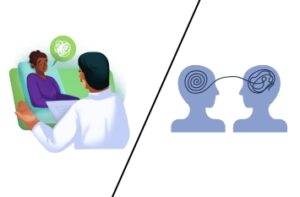
Counseling vs. Therapy: What’s the Difference, and Which One Do You Need?
Counseling vs. Therapy: What’s the Difference, and Which One Do You Need? When You’re Ready to Seek Support When you’re ready to seek support for

Rapid cycling bipolar disorder is a serious and often overwhelming mental health condition that affects a significant portion of individuals diagnosed with bipolar disorder. It’s characterized by rapid shifts between manic and depressive episodes—four or more within a single year—making it more intense than the typical course of bipolar disorder.
Research suggests that up to 10-20% of those with bipolar disorder experience rapid cycling, and women are more likely to be affected than men. These sudden mood changes can drastically impact a person’s life, leading to emotional instability and challenges in managing daily activities.
Understanding this condition is essential, as early intervention and appropriate treatment can help bring stability and improve quality of life.
Rapid cycling bipolar disorder is a specific pattern of mood episodes within the broader category of bipolar disorder. It occurs when a person experiences four or more distinct mood episodes—either manic, hypomanic, or depressive—within a 12-month period.
Unlike traditional bipolar disorder, where mood shifts may happen over months or even years, rapid cycling accelerates this process significantly. The condition is not a separate diagnosis but a specifier, meaning it describes the frequency of mood swings rather than a different type of bipolar disorder.
Rapid cycling can occur in both Bipolar I and Bipolar II, making it a significant variant that can complicate the course of the illness. It is often linked to more severe mood instability and may require different therapeutic approaches for management.
Bipolar disorder comes in various forms, each with distinct patterns of mood episodes and severity. Below are the key types of bipolar disorder:
Rapid cycling bipolar disorder can develop in anyone with a bipolar diagnosis, but certain factors increase its likelihood. Research shows that it affects approximately 10-20% of individuals with bipolar disorder, with women being more frequently affected than men.
It can appear at any point during the illness, often following prolonged periods of untreated or poorly managed bipolar episodes. Individuals with a history of substance abuse, thyroid imbalances, or those not adhering to their treatment plan may also be at a higher risk of developing rapid cycling.
Ultra-rapid cycling bipolar II refers to a subtype of bipolar disorder where mood shifts occur even more frequently than in typical rapid cycling. In this form, individuals experience mood episodes—such as hypomania and depression—within days or even hours rather than over weeks or months.
This rapid fluctuation makes it particularly challenging to diagnose and manage, as the swings are so brief and erratic. Ultra-rapid cycling is more commonly associated with bipolar II, where full mania is not present, but the frequent mood changes can still be deeply disruptive to daily life.
Manic episodes are marked by elevated mood, high energy, and often reckless behavior. In rapid cycling, these episodes occur more frequently, sometimes lasting for days to weeks. Individuals may experience:
Manic episodes are marked by elevated mood, high energy, and often reckless behavior. In rapid cycling, these episodes occur more frequently, sometimes lasting for days to weeks. Individuals may experience:
Hypomania is a milder form of mania that doesn’t cause as severe impairment but still involves elevated mood and increased activity. In rapid cycling, hypomanic episodes are short-lived but frequent. Signs include:
These episodes involve periods of deep sadness, loss of interest, and fatigue, often occurring more than once within a year. Rapid-cycling depressive episodes can cause:
A mixed state occurs when symptoms of both mania and depression are present simultaneously, creating a confusing blend of emotions. During mixed mania in rapid cycling, individuals may experience:
The causes of rapid cycling bipolar disorder are complex and often involve a combination of genetic, biological, and environmental factors. Below are some of the potential contributors to the development of rapid cycling:
Kindling is a neurological phenomenon where repeated mood episodes sensitize the brain, leading to more frequent and intense mood swings over time. This process can make it easier for new episodes to be triggered, even by minor stressors.
Disruptions in the body’s natural biological or circadian rhythms, such as irregular sleep-wake cycles, can contribute to rapid cycling. These rhythms help regulate mood, and when they are out of balance, mood instability may worsen.
Hypothyroidism, or an underactive thyroid, is often associated with rapid cycling. The thyroid gland regulates metabolism, and when it isn’t functioning properly, it can lead to mood fluctuations, including rapid cycling episodes.
In some cases, the use of antidepressants can trigger or exacerbate rapid cycling, particularly in individuals with bipolar disorder. Antidepressants may shift mood toward mania or cause faster cycling between moods if not carefully managed.
Certain physical health conditions, such as chronic illnesses or neurological disorders, can increase the likelihood of rapid cycling. These conditions may interfere with the brain’s ability to regulate mood effectively.
Genetics plays a significant role in bipolar disorder, and rapid cycling is no exception. Individuals with a family history of bipolar disorder are more likely to develop rapid cycling, suggesting a hereditary component.
Though rapid cycling bipolar disorder and borderline personality disorder (BPD) share some similarities, such as mood instability, they are distinct conditions. Rapid cycling bipolar disorder is a mood disorder characterized by episodes of mania, hypomania, and depression, occurring four or more times per year.
BPD, on the other hand, is a personality disorder involving pervasive instability in emotions, relationships, and self-image, often triggered by external events or perceived abandonment.
Aspect | Rapid Cycling Bipolar Disorder | Borderline Personality Disorder (BPD) |
Nature | Mood disorder | Personality disorder |
Mood Episodes | Manic, hypomanic, and depressive episodes | Frequent, intense emotional reactions |
Frequency of Mood Swings | Four or more distinct episodes per year | Mood swings may occur daily or even hourly |
Triggers | Often occur without external triggers | Often triggered by perceived rejection or stress |
Duration of Episodes | Lasts days, weeks, or months | Emotional changes can last minutes to hours |
Treatment | Mood stabilizers, antipsychotics, psychotherapy | Dialectical behavior therapy (DBT), psychotherapy |
Dealing with rapid cycling bipolar disorder requires a comprehensive treatment approach aimed at stabilizing mood, reducing the frequency of episodes, and improving overall quality of life. While there is no single cure, several strategies can help manage the condition effectively, often involving a combination of medication, therapy, and lifestyle adjustments.
Mood Stabilizers: Medications like lithium and anticonvulsants can help regulate mood swings and prevent episodes.
Antipsychotic Medications: These are sometimes prescribed to control manic or mixed episodes, especially if mood stabilizers are insufficient.
Antidepressants (with caution): Used sparingly and often in combination with mood stabilizers to address depressive episodes without triggering mania.
Psychotherapy: Cognitive-behavioral therapy (CBT) and interpersonal therapy can assist in managing stress, developing coping strategies, and maintaining stability.
Regular Sleep Routine: Maintaining consistent sleep patterns is crucial, as disruptions in sleep can worsen rapid cycling.
Exercise and Healthy Diet: Regular physical activity and a balanced diet support overall mental health and help regulate mood.
Avoiding Substance Abuse: Drugs and alcohol can exacerbate mood swings and make treatment less effective.
Frequent Monitoring: Regular visits to a mental health professional help monitor progress and adjust treatments as needed.
Rapid cycling bipolar disorder carries several risks that can significantly impact an individual’s health and daily functioning. Frequent mood swings can lead to increased emotional distress, impaired relationships, and difficulties in maintaining employment or fulfilling daily responsibilities.
The unpredictability of rapid cycling can also increase the risk of self-harm or suicidal thoughts, especially during severe depressive episodes. Additionally, the condition can complicate treatment adherence, as the constant fluctuation in mood may make it challenging to manage medications effectively or engage in consistent therapy.
It’s essential to seek medical attention when experiencing symptoms of rapid cycling bipolar disorder, especially if mood changes become more frequent or severe.
Consulting a doctor is crucial if there are noticeable shifts in mood that interfere with daily life, relationships, or work. Immediate medical advice is needed if there are thoughts of self-harm or suicide, as these require urgent intervention.
Managing rapid cycling bipolar disorder can be challenging due to its frequent and intense mood shifts, but with a comprehensive treatment plan, individuals can achieve stability and improve their quality of life. Early intervention, proper medication, and supportive therapies play a critical role in controlling symptoms and reducing the risk of severe episodes.
By understanding the nature of rapid cycling bipolar disorder and working closely with healthcare professionals, individuals can navigate this complex condition more effectively and lead fulfilling lives.

Counseling vs. Therapy: What’s the Difference, and Which One Do You Need? When You’re Ready to Seek Support When you’re ready to seek support for
